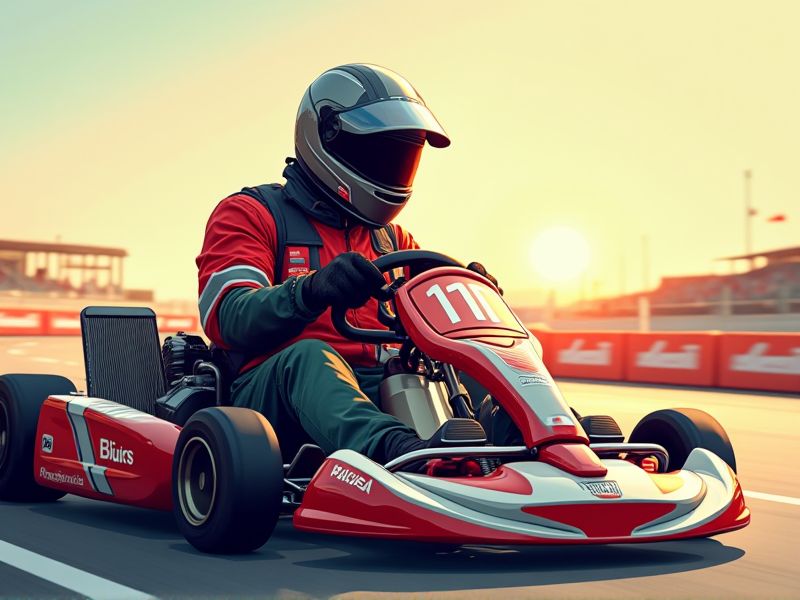
Improving at karting involves focusing on the fundamentals, such as mastering the racing line and braking zones. As Mario Andretti once said, "If everything seems under control, you're not going fast enough," which suggests that pushing beyond comfort zones is crucial for achieving speed and success in karting. By consistently practicing and refining these skills, drivers can identify and address deficiencies in their driving style, leading to better performance on the track. Embracing calculated risks and stepping into uncertainty can help karting enthusiasts tap into their full potential and experience the thrill of racing at higher speeds.
How to Be Better at Karting
Optimize racing lines
Focusing on the optimal racing line through each turn minimizes unnecessary steering and braking, keeping your momentum high. Data analytics show that maintaining a smooth, consistent trajectory through corners can shave off precious milliseconds per lap. Experimenting with different lines and analyzing lap times helps pinpoint the perfect balance between speed and stability. This methodical approach, using real performance data, directly translates to more competitive karting.
Refine braking techniques
Refining braking techniques in karting sharpens your ability to initiate cornering maneuvers with improved timing and control. Mastering progressive brake pressure allows for smoother deceleration, which in turn preserves tire grip and reduces wear. Data indicates that precision braking can reduce lap times by enhancing entry speed without compromising stability. Targeted practice on track under varying conditions helps you identify optimal braking points, directly contributing to a faster, more consistent performance.
Enhance throttle control
Precise throttle control directly affects the kart's stability through corners, allowing smoother transitions and greater consistency in lap times. Quiet and deliberate throttle adjustments help maintain optimal tire traction, minimizing slip and maximizing grip. Regular practice with varying throttle inputs yields measurable improvements in both acceleration and cornering exit speeds. Consistently refining your throttle modulation technique leads to more predictable kart behavior, which, in turn, enhances overall racing performance.
Practice consistency
Practice consistently to build muscle memory that enhances braking precision and cornering techniques. Regular sessions allow you to analyze lap data, thereby identifying key areas where small adjustments yield significant performance gains. Consistency reinforces learning curves, meaning that repeated, focused practice gradually reduces errors on the track. Maintaining a steady routine creates reliable race instincts, ensuring that your strategies become second nature during competitive events.
Analyze track feedback
Collect detailed track feedback using telemetry data, lap time metrics, and on-board recordings to pinpoint specific areas needing improvement. Analyzing these performance indicators helps you identify patterns like suboptimal braking points, inconsistent cornering speeds, and acceleration variations. Comparing this feedback with ideal racing lines and established benchmarks isolates the adjustments needed in driving technique. Incorporating these data-driven insights into your practice sessions leads to smoother cornering, reduced lap times, and overall enhanced karting performance.
Improve weight transfer
Adjust your seating position to maximize the forward or rearward weight shift during braking and cornering. Subtle movements in your body can help balance the load between the front and rear tires, directly influencing grip levels. Experiment with braking techniques to trigger deliberate weight transfer, ensuring that more weight is pressed onto the tires with the highest traction. Data indicates that proactive weight management in karting leads to faster lap times and more consistent handling, making it essential for improved performance.
Adjust kart setup
Begin by analyzing tire pressure, weight distribution, and suspension settings as these factors directly affect kart stability and cornering grip. Adjusting tire pressures can enhance traction and reduce oversteer or understeer, depending on track conditions. Fine-tuning the weight balance and steering geometry allows more precise response and braking performance. Testing and gathering data over multiple sessions will help identify the optimal setup adjustments for consistently improved lap times.
Develop mental focus
Karting performance improves as a direct result of enhanced mental focus, which sharpens your concentration and decision-making during races. Regular mindfulness exercises, such as meditation and deep-breathing techniques, help train your brain to maintain calm and focus under pressure. As your mental clarity grows, you'll be more adept at quickly processing information, strategizing optimal racing lines, and anticipating opponents' moves. Consistently developing mental focus directly correlates with improved lap times and overall racing performance.
Balance risk and strategy
Balancing risk and strategy in karting begins with using data analysis to pinpoint track segments where aggressive tactics can be beneficial without compromising safety. Refining your approach through reviewing race performance metrics enables precise decisions on when to push boundaries and when to maintain conservative control. Adjusting your driving style based on the feedback loop between controlled risks and outcomes leads to consistently better lap times. Regular practice paired with performance review transforms statistical insights into tangible improvements on the track.
Increase physical conditioning
Increasing physical conditioning improves your endurance, reaction time, and focus on the track, giving you a competitive advantage during intense races. Regular cardiovascular and strength training builds the muscle stamina required to handle the high g-forces experienced during sharp turns and sudden stops. Enhanced core stability and flexibility also help maintain better balance and control over the kart, reducing the risk of errors in high-speed maneuvers. By systematically incorporating fitness drills that simulate race conditions, you prime your body to perform at its peak during competitions.
Summary
Optimizing your racing lines allows you to maintain momentum through each segment of the track, reducing lap times effectively. Refining braking techniques translates to smoother deceleration, which is essential for efficient corner entry and exit. Enhancing throttle control ensures you deliver power seamlessly, maintaining traction and stability throughout the race. Focusing on these three critical areas creates a comprehensive strategy for advancing your karting performance.
